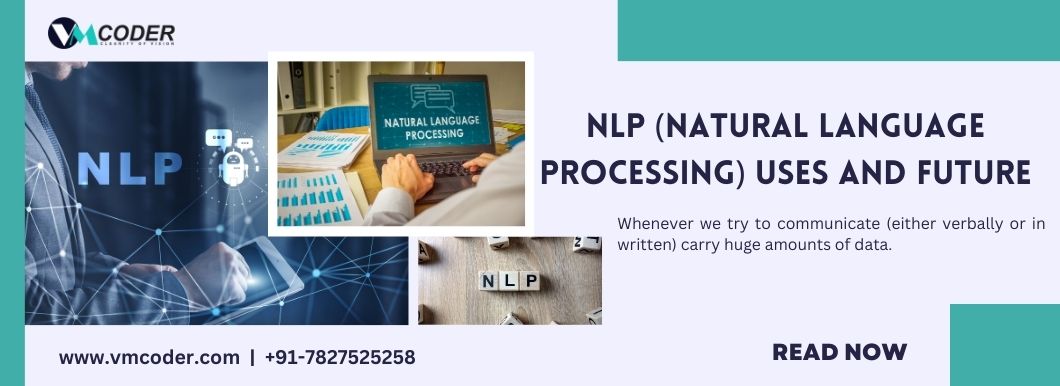NLP Uses and Future
Whenever we try to communicate (either verbally or in written) carry huge amounts of data. The topic we elect, our tone, our selection of words, everything adds some sort of information which will be interpreted and values is often extracted from it. In theory, we will understand and even predict human behavior using that information.
But there’s a problem: one person may generate hundreds or thousands of words during a declaration, each sentence with its corresponding complexity. If you would like to scale and analyze several hundred, thousands, or many people or declarations during given geography, then things are unmanageable.
Data generated from conversations, declarations, or maybe tweets give rise to unstructured data. Unstructured data doesn’t fit neatly into the normal row and column structure of relational databases, and represent the overwhelming majority of knowledge available within the actual world. it’s messy and hard to control. Nevertheless, because of the advances in disciplines like machine learning, an enormous revolution goes on regarding this subject. Nowadays it’s not about trying to interpret text or speech supported by its keywords (the quaint mechanical way), but about understanding the meaning behind those words (the cognitive way). This way, it’s possible to detect figures of speech like irony or maybe perform sentiment analysis.
Natural Language Processing or NLP may be a field of AI that provides the machines the power to read, understand and derive meaning from human languages.
It is an authority that centers its focus on the interaction between data science and human language and is expanding to countless industries. Today, NLP is booming because of huge improvements within the access to data and increases in computational power, which are allowing practitioners to realize meaningful leads to areas like healthcare, media, finance, and human resources, among others.
VARIOUS CASES OF NLP:-
In easier words, it represents the computerized handling of natural human languages like text or speech, and although it’s quite fascinating, the real value behind this technology comes from the use cases.
It can help you with assisting with lots of tasks on a daily basis. Let’s discuss some examples:
It generates the popularity and prediction of diseases supported by electronic health records and patient’s own speech. The capabilities are being inspected in health conditions that go from cardiovascular diseases to depression and even schizophrenia. For example, Amazon Comprehend Medical may be a service that uses NLP to extract disease conditions, medications, and treatment outcomes from patient notes, clinical test reports, and other electronic health records.
Organizations can determine what customers are saying about a few services or products by identifying and extracting information from sources like social media. This sentiment analysis can provide tons of data about customers’ choices and their decision drivers.
An inventor at IBM developed a cognitive assistant that works sort of a personalized program by learning all about you then reminds you of a reputation, a song, or anything you can’t remember the instant you would like it to.
Companies like Yahoo and Google filter and categorize your emails with the help of NLP by observing text in emails that flow through their servers and ceases the spam before they even enter your inbox.
To help to spot fake news, the NLP Group at MIT developed a replacement system to work out if a source is accurate or politically biased, detecting if a news source can be trusted or not.
Amazon’s Alexa and Apple’s Siri are great examples of intelligent voice-driven interfaces which able them to respond to vocal prompts with the help of NLP and do everything like find a particular shop, tell us the weather forecast, suggest the best route to the office, etc.
Able to get insight into what is happening currently and what people are discussing can be a very considerable aspect to financial traders. NLP is getting used to trace news, reports, comments about possible mergers between companies, everything is often then incorporated into a trading algorithm to get massive profits. Remember: buy the rumor, sell the news.
NLP is additionally getting used in both the search and selection phases of talent recruitment, identifying the talents of potential hires and also spotting prospects before they become active on the job market.
In today’s time, it is specifically booming in the healthcare industry. This technology is improving healthcare delivery, disease diagnosis, and bringing costs down while healthcare organizations are browsing a growing adoption of electronic health records. The fact that clinical documentation is often improved means patients are often better understood and benefited through better healthcare. The goal should be to optimize their experience, and a number of other organizations are already working on this.
NLP’S REACH IN FUTURE:-
At the instant, NLP is battling to detect nuances in language meaning, whether thanks to lack of context, spelling errors, or dialectal differences.
In March 2016 Microsoft invented Tay, an Artificial Intelligence (AI) chatbot it was released on Twitter as an example of an NLP experiment. The idea was to know regarding people preferences and their response towards Tay the more people will prefer it the smarter it might get. Well, the result was that after 16 hours Tay had to be removed thanks to its racist and abusive comments:
Microsoft learned from its own experience and a few months later released Zo, its second-generation English-language chatbot that won’t be caught making an equivalent mistake as its predecessor. Zo uses a mixture of innovative approaches to acknowledge and generate conversation, and other companies are exploring with bots that will remember details specific to a private conversation.
Although the longer term looks extremely challenging and filled with threats for NLP, the authority is developing at a really huge scale, and that we are most likely to reach A level of advancement within the coming years which will make complex or complicated applications simpler.
Written by :
Shweta Bhatia
Leave a Reply
Your email address will not be published. Required fields are marked *






